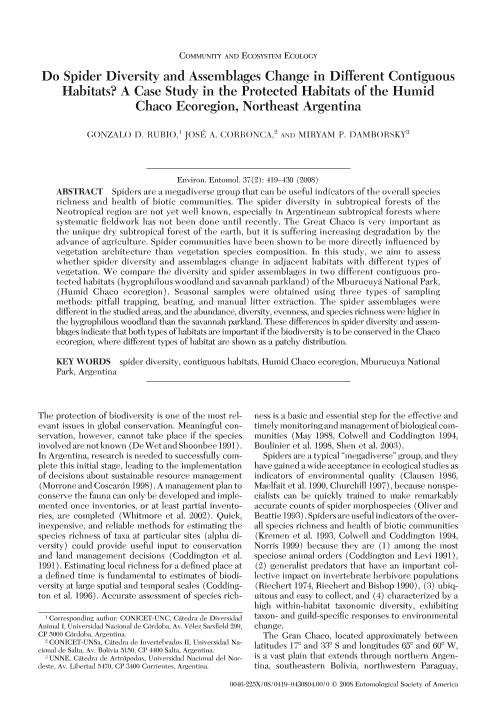Mostrar el registro sencillo del ítem
dc.contributor.author
Rubio, Gonzalo Daniel

dc.contributor.author
Corronca, Jose Antonio

dc.contributor.author
Damborsky, Miryam Pieri

dc.date.available
2019-06-18T20:39:54Z
dc.date.issued
2008-04
dc.identifier.citation
Rubio, Gonzalo Daniel; Corronca, Jose Antonio; Damborsky, Miryam Pieri; Do Spider Diversity and Assemblages Change in Different Contiguous Habitats? A Case Study in the Protected Habitats of the Humid Chaco Ecoregion, Northeast Argentina; Oxford University Press; Environmental Entomology; 37; 2; 4-2008; 419-430
dc.identifier.issn
0046-225X
dc.identifier.uri
http://hdl.handle.net/11336/78495
dc.description.abstract
Spiders are a megadiverse group that can be useful indicators of the overall species richness and health of biotic communities. The spider diversity in subtropical forests of the Neotropical region are not yet well known, especially in Argentinean subtropical forests where systematic Þeldwork has not been done until recently. The Great Chaco is very important as the unique dry subtropical forest of the earth, but it is suffering increasing degradation by the advance of agriculture. Spider communities have been shown to be more directly inßuenced by vegetation architecture than vegetation species composition. In this study, we aim to assess whether spider diversity and assemblages change in adjacent habitats with different types of vegetation. We compare the diversity and spider assemblages in two different contiguous protected habitats (hygrophilous woodland and savannah parkland) of the Mburucuya´ National Park, (Humid Chaco ecoregion). Seasonal samples were obtained using three types of sampling methods: pitfall trapping, beating, and manual litter extraction. The spider assemblages were different in the studied areas, and the abundance, diversity, evenness, and species richness were higher in the hygrophilous woodland than the savannah parkland. These differences in spider diversity and assemblages indicate that both types of habitats are important if the biodiversity is to be conserved in the Chaco ecoregion, where different types of habitat are shown as a patchy distribution.
dc.format
application/pdf
dc.language.iso
eng
dc.publisher
Oxford University Press

dc.rights
info:eu-repo/semantics/openAccess
dc.rights.uri
https://creativecommons.org/licenses/by-nc-sa/2.5/ar/
dc.subject
Spider Diversity
dc.subject
Contaguous Habitats
dc.subject
Humid Chaco Ecoregion
dc.subject
Mburucuya National Park
dc.subject.classification
Otras Ciencias Biológicas

dc.subject.classification
Ciencias Biológicas

dc.subject.classification
CIENCIAS NATURALES Y EXACTAS

dc.title
Do Spider Diversity and Assemblages Change in Different Contiguous Habitats? A Case Study in the Protected Habitats of the Humid Chaco Ecoregion, Northeast Argentina
dc.type
info:eu-repo/semantics/article
dc.type
info:ar-repo/semantics/artículo
dc.type
info:eu-repo/semantics/publishedVersion
dc.date.updated
2019-03-26T20:36:00Z
dc.journal.volume
37
dc.journal.number
2
dc.journal.pagination
419-430
dc.journal.pais
Reino Unido

dc.journal.ciudad
Oxford
dc.description.fil
Fil: Rubio, Gonzalo Daniel. Consejo Nacional de Investigaciones Científicas y Técnicas; Argentina. Universidad Nacional de Córdoba; Argentina
dc.description.fil
Fil: Corronca, Jose Antonio. Consejo Nacional de Investigaciones Científicas y Técnicas; Argentina. Universidad Nacional de Salta; Argentina
dc.description.fil
Fil: Damborsky, Miryam Pieri. Universidad Nacional del Nordeste; Argentina. Consejo Nacional de Investigaciones Científicas y Técnicas; Argentina
dc.journal.title
Environmental Entomology

dc.relation.alternativeid
info:eu-repo/semantics/altIdentifier/url/https://academic.oup.com/ee/article/37/2/419/501041
dc.relation.alternativeid
info:eu-repo/semantics/altIdentifier/doi/http://dx.doi.org/10.1093/ee/37.2.419
Archivos asociados
